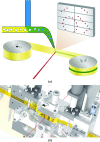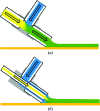Mix-and-diffuse serial synchrotron crystallography
- PMID: 29123679
- PMCID: PMC5668862
- DOI: 10.1107/S2052252517013124
Mix-and-diffuse serial synchrotron crystallography
Abstract
Unravelling the interaction of biological macromolecules with ligands and substrates at high spatial and temporal resolution remains a major challenge in structural biology. The development of serial crystallography methods at X-ray free-electron lasers and subsequently at synchrotron light sources allows new approaches to tackle this challenge. Here, a new polyimide tape drive designed for mix-and-diffuse serial crystallography experiments is reported. The structure of lysozyme bound by the competitive inhibitor chitotriose was determined using this device in combination with microfluidic mixers. The electron densities obtained from mixing times of 2 and 50 s show clear binding of chitotriose to the enzyme at a high level of detail. The success of this approach shows the potential for high-throughput drug screening and even structural enzymology on short timescales at bright synchrotron light sources.
Keywords: X-ray crystallography; drug discovery; lysozyme; protein structure; serial crystallography; time-resolved studies.
Figures




References
-
- Adams, P. D. et al. (2010). Acta Cryst. D66, 213–221. - PubMed
-
- Barends, T. R. M. et al. (2015). Science, 350, 445–450. - PubMed
-
- Barends, T. R. M., Foucar, L., Botha, S., Doak, R. B., Shoeman, R. L., Nass, K., Koglin, J. E., Williams, G. J., Boutet, S., Messerschmidt, M. & Schlichting, I. (2014). Nature (London), 505, 244–247. - PubMed
-
- Blake, C. C. F., Johnson, L. N., Mair, G. A., North, A. C. T., Phillips, D. C. & Sarma, V. R. (1967). Proc. R. Soc. B Biol. Sci. 167, 378–388. - PubMed
LinkOut - more resources
Full Text Sources
Other Literature Sources

